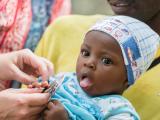Oct 26, 2010
Detroit officials nix high-dose flu vaccine for seniors
Health officials in the Detroit metro area have decided not to buy high-dose flu vaccine designed for the elderly because of cost and potential confusion for consumers, the Detroit Free Press reported today. "It's not a criticism of the vaccine. It's a matter of keeping it simple," said Steve Gold, director of the Macomb County Health Department. The Sanofi vaccine, Fluzone High-Dose, has four times the antigen of regular flu vaccine to boost the response in seniors, whose immune response to the shot often lags that of younger people. The story said local costs for Fluzone High-Dose ran from double to triple that of regular seasonal flu vaccine.
Cholera cases confirmed in Port-au-Prince area
Haiti's health ministry yesterday reported 3,342 confirmed cholera cases, including 259 deaths—an increase of 327 cases and 6 deaths from its Oct 24 report, the World Health Organization (WHO) said in a statement today. Officials are investigating suspected cholera cases in Haiti's North and South departments, and five cases have been confirmed the country's West department, which includes the capital, Port-au-Prince. The WHO's Region for the Americas, known as the Pan American Health Organization (PAHO), is mobilizing experts, lab equipment, water and sanitation materials, and humanitarian supplies to Haiti and its neighbor, the Dominican Republic. So far, no cholera cases have been detected in the Dominican Republic, but government officials have launched a contingency plan at the border area, the WHO said. PAHO's Caribbean Epidemiology Center in Trinidad is helping Caribbean countries prepare for the spread of cholera to other islands. Health officials haven't confirmed the source of the cholera outbreak, but contamination of the Artibonite River, which crosses Haiti's rural center, is suspected, Agence France-Presse (AFP) reported today. Elisabeth Byrs, a spokeswoman for the UN Organization for the Coordination of Human Affairs, told AFP that most of the cholera cases were in people from rural areas who worked in rice fields, especially Artibonite's seasonal workers.
Oct 26 WHO statement
Oct 26 AFP story
New bivalent polio vaccine shows promise
A new bivalent (two-strain) oral polio vaccine induced an immune response stronger than that of the existing trivalent vaccine and similar to that of the existing monovalent vaccine, according to a study published online today in The Lancet. The new vaccine contains strains for the two remaining wild-type polioviruses, types 1 and 3. The researchers vaccinated 830 newborn babies in India with either the monovalent, bivalent, or trivalent vaccines in two doses, one at birth and one 30 days later. Two-dose seroconversion to poliovirus type 1 (defined as a titer four times higher than expected) was 90% (151 of 168) for the monovalent vaccine and 86% (136 of 159) for the bivalent form, compared with 63% (106 of 168) for the trivalent formula. Seroconversion to type 3 was 84% (138 of 165) for the monovalent vaccine, 74% (117 of 159) for the bivalent form, and 52% (87 of 168) for the trivalent vaccine. All the vaccines were well tolerated. The authors write that the major advantages of the bivalent vaccine "is that it will enhance individual and population immunity simultaneously for both poliovirus types 1 and 3, without any serious loss in immunogenicity" compared with the monovalent vaccine.
Oct 26 Lancet abstract
Oct 25 Lancet press release
Massive polio vaccination drive targets Africa's children
International groups and African nations are making an unprecedented push this week to block the spread of polio on the African continent. The goal is to reach 72 million children in 15 countries with polio vaccine in a door-to-door campaign conducted by about 290,000 vaccinators, the World Health Organization (WHO) said today in a press release. African nations were able to slow to a trickle the spread of polio from Nigeria to 24 other nations with synchronized vaccination campaigns in 2009 and early 2010. However, other polio events have illustrated the risk of incomplete eradication efforts. Liberia reported a polio case in September, Mali reported a new importation of wild poliovirus 3, and a polio case was reported in Uganda, a country that had been polio-free for more than a year. Global health officials have said the greatest threat to polio eradication efforts in Africa are recent disease outbreaks in Angola that have spilled over into neighboring Democratic Republic of Congo. Dr Luis G. Sambo, the WHO's regional director for Africa, said both countries have taken steps to close polio vaccination gaps. "We are seeing the essential government support that can make the difference between success and failure. But much more remains to be done to fill the gaps if we are to protect the stunning gains made this year," he said in the statement. The 15-country synchronized vaccination drive will cost about $42 million and is funded by the Bill & Melinda Gates Foundation, the US Centers for Disease Control and Prevention, the US Agency for International Development, Rotary International, the United Nations Children's Fund (UNICEF), and the governments of Germany and Japan.
Oct 26 WHO press release
Grant awarded to address antibiotic-resistant disease in cattle
The US Department of Agriculture has awarded a Kansas State University epidemiologist a $2 million grant to manage antibiotic-resistant disease in US and Canadian cattle, according to a Kansas State news release yesterday. H. Morgan Scott, a professor of diagnostic medicine and pathobiology, will collaborate on the project with researchers from the University of Guelph in Ontario, Angelo State University in Texas, Texas Tech University, Texas A&M University, Cornell University, Colorado State University, and the Public Health Agency of Canada. Scott said, "We focus on the longstanding problem of resistance emergence, dissemination and persistence among enteric bacteria. If pathogenic bacteria resistant to antibiotics enter the food chain, treatment of humans can be complicated." He noted that researchers will assess, then improve the quality of education and extension materials for veterinarians and farmers. The Food and Drug Administration is exploring the possibility of limiting agricultural antibiotic use to help combat resistant pathogen strains. "We want to employ molecular microbiology to discover the mechanisms underlying several paradoxical responses of resistant strains to antibiotic selection pressures," Scott said, who would then field-test practical interventions in dairy and beef cattle.
Oct 25 Kansas State press release





















